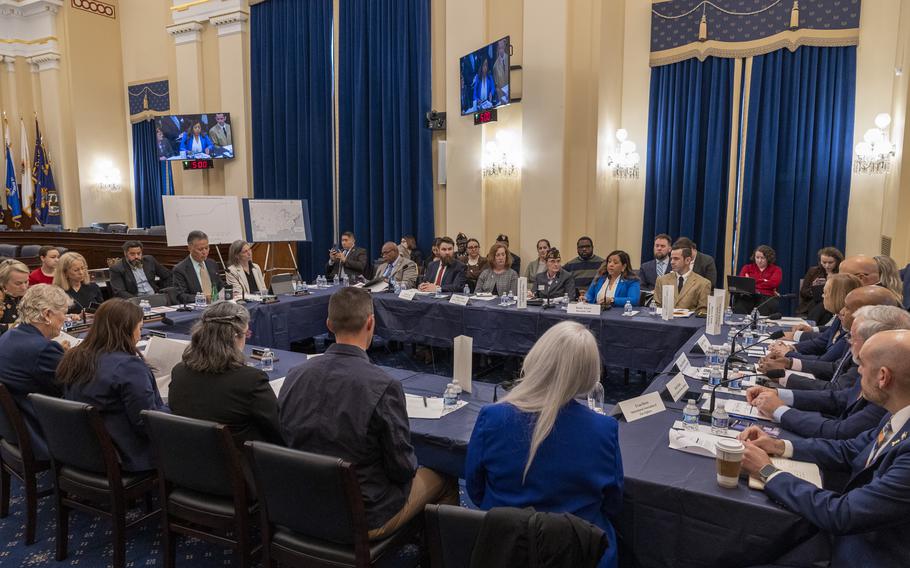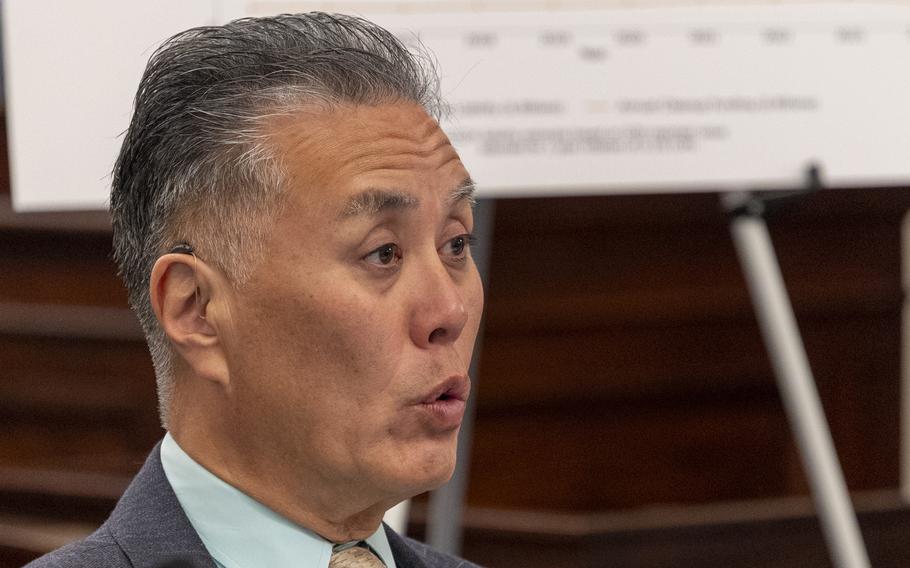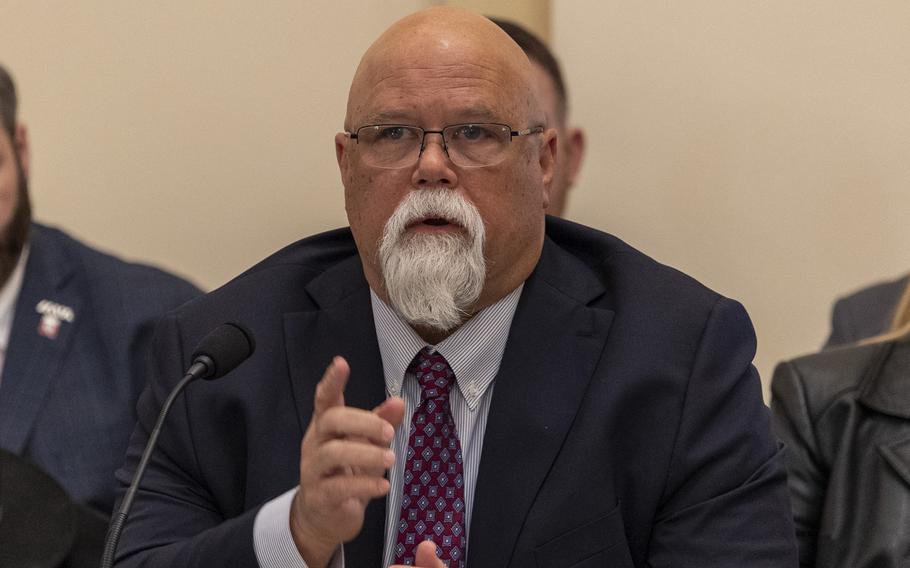
A discussion with veterans and nonprofit groups about toxic exposures at U.S. military bases was orchestrated by Sen. Richard Blumenthal, D-Conn., and Rep. Mark Takano, D-Calif., on Tuesday, April 8, 2025. (Eric Kayne/Stars and Stripes)
WASHINGTON — Dave Crete, a former Air Force sergeant at a Nevada installation where nuclear bombs were tested, developed tumors in his brain and throughout his body years after he worked as a military police officer at the facility in the 1980s.
But Crete, 60, said it was not until he began connecting on social media with former military buddies that he served with at the Nevada Test and Training Range that he learned several of them also had tumors and their wives experienced multiple miscarriages, as his wife did.
Crete traveled from his Las Vegas home to meet with lawmakers Tuesday and push for the Department of Veterans Affairs for the first time to provide health care and survivor benefits for veterans exposed to radiation while serving at the classified installation. Legislation was introduced in February to support the additional coverage, he said.
Crete joined a discussion held by Democrats on the House and Senate Veterans’ Affairs committees that focused on exposures to hazardous materials at U.S. military bases.
The informal talk, held at a House office building, was organized by Rep. Mark Takano of California and Sen. Richard Blumenthal of Connecticut, the top Democrat on each committee.

Rep. Mark Takano, D-Calif., speaks Tuesday, April 8, 2025, during a discussion with veterans and nonprofit groups about toxic exposures at U.S. military bases. (Eric Kayne)
The lawmakers said their goal was to draw attention to efforts by Democrats to expand coverage under the 2022 PACT Act, as President Donald Trump’s administration orders sweeping staff cuts across the VA. Takano argued the cuts will impact the delivery of benefits and compensation to veterans.
“The PACT Act is under attack,” Takano said about the Sergeant First Class Heath Robinson Honoring our Promise to Address Comprehensive Toxics Act that provides benefits for veterans sickened from exposures to hazardous materials.
Republican lawmakers did not take part in Tuesday’s discussion.
More than a dozen veterans offered their firsthand accounts of experiences serving at military bases in the United States where they were exposed to a variety of harmful substances, including industrial solvents, chemicals in firefighting foams and mold in housing.
Crete said he has been unable to get VA coverage for his radiation exposure while at the Nevada installation because the site where he served was secret. Nuclear testing ended in 1992, but the site is still contaminated, he said.

David Crete, a veteran and chairman of The Invisible Enemy, speaks Tuesday, April 8, 2025, during a discussion about toxic exposures at U.S. military bases. (Eric Kayne/Stars and Stripes)
The Defense Department does not acknowledge the site or the nuclear tests that were conducted there, Crete said.
“I am asking Congress to please allow us to get the benefits every other veteran earned. We are not asking to be special but to be treated equal,” he said.
Many of the veterans said they have faced lengthy battles trying to obtain information about the toxic exposures, as well as qualifying for services and benefits.
Takano said there is a need for greater focus on toxic exposures at U.S. military bases.
“We must push back against the idea that service members are only in harm’s way in war zones,” he said.
Invited participants included veterans and several nonprofit groups — such as Torchlight Initiative, the Invisible Enemy and Burn Pits 360 — that advocate for veterans with toxic exposures.
Mandy Feindt, a major in the Army, discussed her experiences serving at Joint Base Pearl Harbor-Hickam in Hawaii, the site of a large jet fuel spill in 2021. Feindt lived in a home on Ford Island at the time.
The fuel seeped into the drinking water system at the base without families on the base knowing about it, she said.
“The Navy did not capture all the fuel and did not tell us we were slowly being poisoned,” Feindt said.
The drinking water system serves about 93,000 people who are predominantly military families, she said.
Feindt said she had to beg the military to test family members when her children became sick after the spill.
“I wanted to know what my children consumed,” she said. “Access to basic clean water should be a human right.”
Feindt said her family experienced chronic health problems that they continue to deal with today.
The VA was later ordered by Congress to conduct a study on the human impact but that has yet to be done, she said.
More than 3,500 U.S. military installations have some form of contamination, said Jared Hayes, senior policy analyst at the Environmental Working Group, a nonprofit in Washington, D.C. He estimated the total cost for cleanup as $50 billion.
Crete now runs a nonprofit called the Invisible Enemy, which advocates for the VA to provide medical services and compensation for services members who experienced radiation exposure at the Nevada Test and Training Range.
“I want to get benefits to those who served — the veterans and employees,” said Crete, who started the organization in April 2023. “We’re basically being denied benefits. It’s the right thing for Congress to do.”